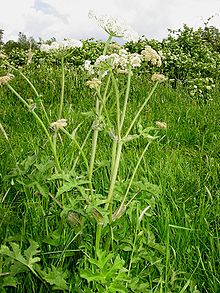Common hogweed
| Heracleum sphondylium | |
|---|---|
 |
|
| Scientific classification | |
| Kingdom: | Plantae |
| (unranked): | Angiosperms |
| (unranked): | Eudicots |
| (unranked): | Asterids |
| Order: | Apiales |
| Family: | Apiaceae |
| Genus: | Heracleum |
| Species: | H. sphondylium |
| Binomial name | |
|
Heracleum sphondylium L. |
|
| Synonyms | |
|
|
Heracleum sphondylium, commonly known as hogweed, common hogweed or cow parsnip, is a herbaceous perennial or biennial plant, in the umbelliferous family Apiaceae that includes fennel, cow parsley, ground elder and giant hogweed. It is native to Europe and Asia. The common name eltrot may also be applied, but is not specific to this species. Umbelliferous plants are so named because of the umbrella-like arrangement of flowers they produce. The North American species Heracleum maximum (also called cow parsnip) is sometimes included as a subspecies of H. sphondylium.
The genus name Heracleum derives from the Greek "herákleion" and refers to the mythologic hero Heracles, while the species name sphondylium, meaning "vertebrate", refers to the shape of the segmented stem.
Heracleum sphondylium reaches on average 50–120 centimetres (20–47 in) of height, with a maximum of 2 metres (6 ft 7 in). From large reddish rhizomatous roots rises a striated, ridged, hollow stem with bristly hairs. The leaves can reach 50 centimetres (20 in) of length. They are pinnate, hairy and serrated, divided into 3–5 lobed segments.
This plant has pinkish or white flowers with 5 petals. They are arranged in large umbels of up to 20 cm of diameter with 15 to 30 rays. The peripheral flowers have a radial symmetry. Flowering typically occurs between June and October.
The terminal umbels are flat-topped and the outermost petals are enlarged.
The flowers are pollinated by insects, such as beetles, wasps and especially flies. The small fruits are flattened and winged, elliptical to rounded and glabrous, up to 1 cm long. The seed dispersal is by wind (anemochory).
The characteristic pig-like smell of the flowers gives it its name.
H. sphondylium is smaller than the skin-irritating Heracleum mantegazzianum (giant hogweed). There is some apocryphal evidence that the sap from common hogweed can also produce burns and rashes. Care needs to be used when cutting or trimming it.
...
Wikipedia
